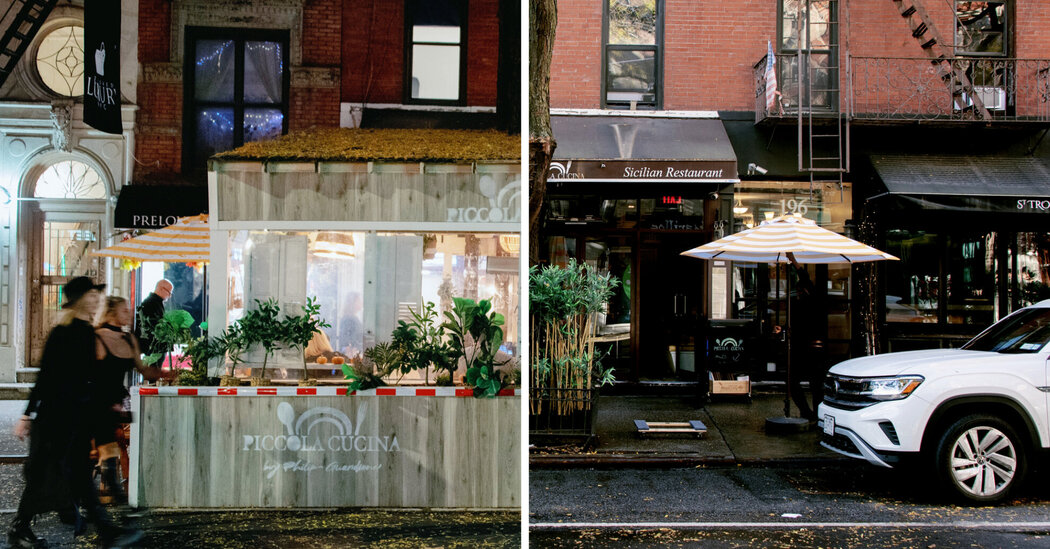When Suzette Mullen finally acknowledged her complicated feelings for the woman she considered her best friend, she felt the weight of a significant question: Am I gay?
Ms. Mullen, then 54, had been married for more than two decades to her husband, whom she loved. They lived together in Montauk, N.Y., and had two adult sons. She didn’t have anyone she could talk to about the feelings she had been harboring.
So Ms. Mullen, an author and editor with a law degree from Harvard, went online, searching “late in life and coming out” and “How to know if you are gay?” on Google.
She quickly found communities of women, on websites like Facebook, with some of them asking similar questions. In response to a post Ms. Mullen shared in a private Facebook group, a woman in her late 40s confirmed certain suspicions that she had been confronting about her sexual identity.
“You are a lesbian,” the woman wrote. “The only question is: What now?”
For Ms. Mullen, the answer was partly to learn a new language to describe herself. She was a LILLE, an acronym some use to refer to a late-in-life lesbian. (Lifelong lesbians, she learned, had their own abbreviation: L.L.L.) Her best friend was a catalyst, a term referring to a woman who awakens another’s lesbian identity. And Ms. Mullen and her husband were in what some referred to as a mixed-orientation marriage, or MOM.
This lexicon was just part of what Ms. Mullen, now 63, encountered in those online communities, which she said played a pivotal role as she navigated the process of divorcing her husband and living as a lesbian.
Ms. Mullen wrote about that experience in her recently released memoir, “The Only Way Through Is Out.” The book is an expansion of a short story she had published in The New York Times in 2021.
Like many divorces, Ms. Mullen’s was complicated. “There were a lot of emotions involved,” said her elder son, Will Harrel, 32. “Excitement for her, but also fear and uncertainty about the loss of the family unit.”
Ms. Mullen’s memoir is part of a media genre that includes Glennon Doyle’s book “Untamed” — which recounts how Ms. Doyle, at 39, left her husband for the professional soccer player and coach Abby Wambach — and “Am I OK?,” a new film starring Dakota Johnson as a 30-something who comes out as a lesbian. It was directed by the comedian Tig Notaro and her wife, Stephanie Allynne, who also identifies as a late-in-life lesbian. (The term can apply to women middle-aged and older who come out, or women of any age who had heterosexual relationships before coming out.)
Ms. Mullen said that, since the release of her book in February, she had received dozens of messages on Facebook and Instagram from women who relate to her story. “Being able to access support on the internet is crucial for so many,” she said.
Before much of daily life migrated online, lesbians typically found community at book shops and bars, or through publications like Lesbian Connection, a magazine started in 1974. It still publishes a list of lesbians around the country who are open to receiving correspondence and visits from women making sense of their sexual identities.
But the rise of networking websites and social media, along with evolving attitudes toward identity, have made it easier for people to talk openly with others about their sexuality.
Christine Terpening, 53, a former rodeo cowgirl, was raised in Vermontville, Mich., an area with only hundreds of residents. Ms. Terpening, who still lives on the dirt road she grew up on, came out as a lesbian at 44, as a married mother of three. She described the revelation as terrifying, partly because attitudes toward homosexuality in her rural community were often negative.
When Ms. Terpening came out in 2014, she said, some people she had known since childhood started to look at her askance. Online, however, she found more supportive communities, which, along with her family, helped her find her footing as a late-in-life lesbian. She is still legally married to her husband; they still share a home, too — but not a bedroom.
Ms. Terpening now runs an organization offering services to teenagers in rural areas who identify as L.G.B.T.Q.I.A.+. Some of them, she said, have also helped people who came out later in life like herself. “The bravery of generations younger than us encouraged us to not suppress ourselves any longer,” Ms. Terpening said.
A recent Gallup poll reported that nearly 8 percent of Americans identified as L.G.B.T.Q.I.A.+ in 2023, about two percentage points more than in 2020. About 15 percent of those respondents identified as lesbians in the latest poll, up from about 12 percent. Members of younger generations — Gen-Zers, millennials — identified as L.G.B.T.Q.I.A.+ in far greater numbers than Gen-Xers and baby boomers; this was the case in the previous poll as well.
Miriam Grace, a 58-year-old psychotherapist in Britain who came out when she was 50, surveyed more than 2,000 late-in-life lesbians between the ages of 40 and 65 for the book “Queering Gestalt Therapy,” which was released last year. (The title refers to a form of psychotherapy.)
She said some of those women said that they had always thought that they were lesbians, but had heterosexual relationships because they feared personal or professional discrimination. Others said that they had considered their sexuality to be fluid, and came out as lesbians after developing a strong attraction to another woman. A third group consisted of women who said they were not able or willing to embrace their lesbian identity in earlier years, but that, reflecting on their lives, they could see that they were always lesbians.
“Women who devoted themselves to motherhood, or who believed their sexuality is irrelevant or dirty, may be unaware of their authentic sexuality until space opens in later life,” Ms. Grace said.
Anne-Marie Zanzal, 60, a mother of four, came out as a lesbian at 52 after 27 years of marriage. Her ensuing divorce was hard on her children, who struggled with its effect on what until then was a close-knit family.
“I raised them to be progressive,” said Ms. Zanzal, a United Church of Christ minister in Nashville. “However, it is different when your mom, who you thought was straight, is gay.”
Two years after Ms. Zanzal came out, she started a podcast, “Coming Out and Beyond.” Hers is one of several podcasts that focus on the late-in-life lesbian experience; others include “The Stories We Tell,” which was started by Jaime Messina, who runs a Facebook group called Club LILLES. It has some 8,000 members: Most are between the ages of 35 and 54, but some are in their 20s and others in their 70s.
Ms. Messina, 42, came out in 2001, at 18, after exploring her sexuality in AOL chat rooms. Ms. Messina, who has about 120,000 followers on TikTok, said social media has played a “huge role” in helping late-in-life lesbians connect and navigate what she described as the intense skepticism some can face.
“Unlike those coming out as teenagers, they are continually asked, ‘You sure? How do you know?’” said Ms. Messina, who lives in St. Petersburg, Fla.
Tasha Shelton, 48, a hair stylist and mother of three in Nashville, is a member of Club LILLES. She said it was only after her and her ex-husband’s marriage fell apart in 2016 when she began to think more about her sexual identity. She had not done so sooner, she said, largely because she was raised Southern Baptist.
Ms. Shelton’s children had mixed reactions when she came out, she said, but all ultimately accepted her decision.
“The support of groups like LILLES makes you see that you’re not the only one sailing in the murky waters,” she said.







